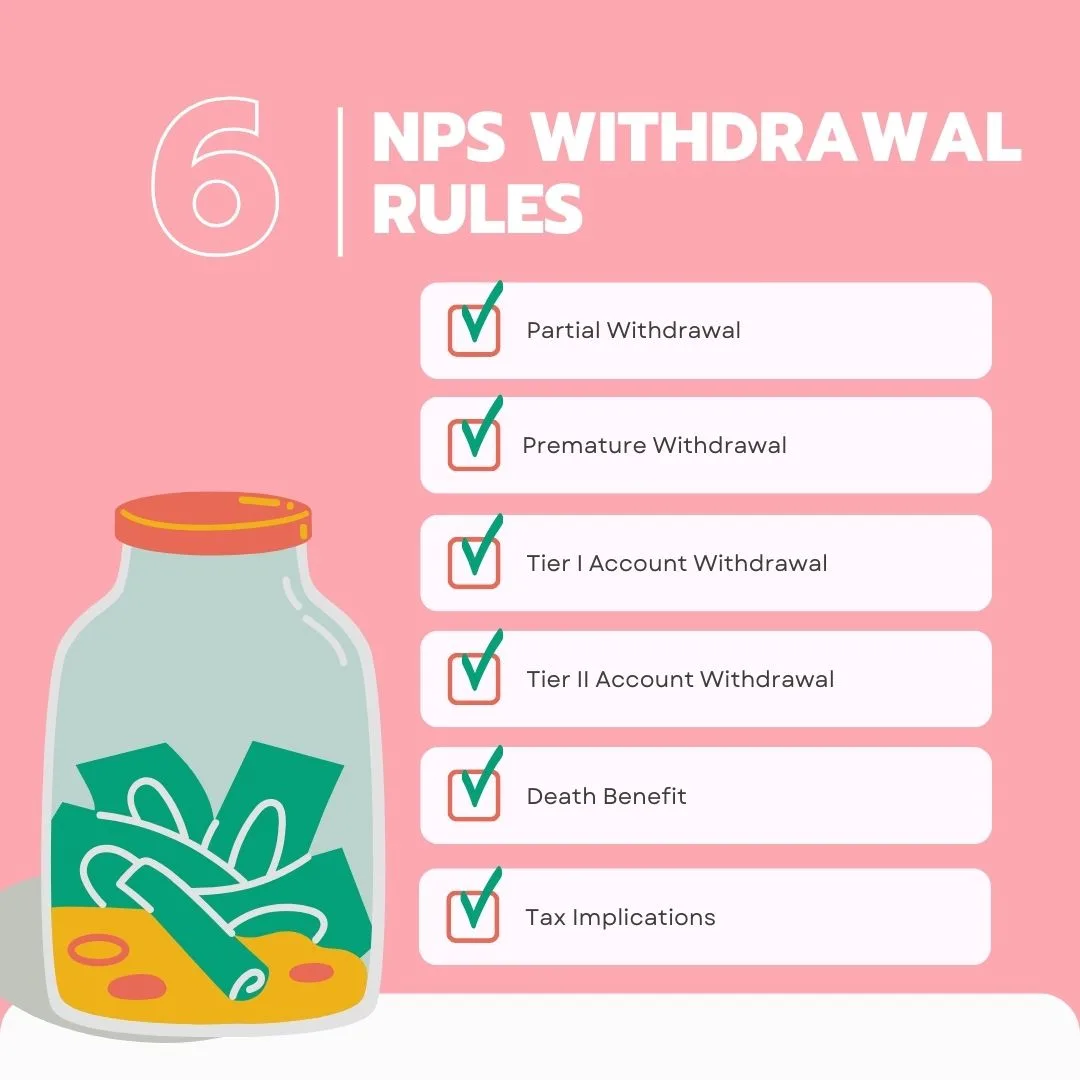Are you considering the National Pension System (NPS) as part of your retirement planning? Understanding the rules surrounding NPS withdrawals is essential for effectively managing your financial future. In this comprehensive guide, we’ll break down the intricacies of NPS withdrawal rules, providing you with clear and concise information to navigate your retirement investments with confidence.
As we delve into the specifics of NPS withdrawal regulations, we’ll explore various scenarios, including partial and premature withdrawals, tier-wise account considerations, death benefits, and tax implications. By the end of this guide, you’ll have a solid understanding of how NPS withdrawals work, empowering you to make informed decisions tailored to your financial goals and circumstances.
So let’s embark on this journey to demystify NPS withdrawal rules and pave the way for a secure and prosperous retirement.
NPS Withdrawal Rules 2024: A Comprehensive Guide
Planning for retirement involves making informed decisions, especially regarding your investment choices like the National Pension System (NPS). Understanding the NPS withdrawal rules is crucial for managing your finances effectively. Let’s explore these rules in detail:
1. Partial Withdrawal:
Partial withdrawals from NPS are permitted under specific circumstances, such as medical emergencies, education, marriage expenses, or house construction. Subscribers can make up to three partial withdrawals during their tenure, with a mandatory five-year gap between each withdrawal. The amount withdrawn is limited to 25% of the contributions made, and only the principal amount can be withdrawn, excluding the interest earned.
2. Premature Withdrawal:
Both corporate sector employees and government employees can make premature withdrawals under different conditions. Corporate sector employees, upon early retirement, are required to invest 80% of the corpus in annuity plans, with the remaining 20% available as a lump sum. Government employees must use at least 80% of their corpus to purchase annuities upon early retirement.
3. Tier I Account Withdrawal:
Before 2011, Tier I accounts had a lock-in period until the age of 60. However, now withdrawals are allowed after 15 years of service, with the option to withdraw up to 50% after 25 years. Withdrawals are permitted for emergencies, medical illnesses, and other significant life events.
4. Tier II Account Withdrawal:
Withdrawals from NPS Tier II accounts are unlimited, resembling a savings bank account. However, the withdrawal process can be cumbersome due to limited withdrawal options and the absence of an online portal.
5. Death Benefit:
In the unfortunate event of the subscriber’s demise, the entire accumulated corpus is passed on to the nominee or legal heir. The nominee has the option to choose an annuity plan if they wish to continue with the NPS benefits.
6. Tax Implications:
Partial withdrawals from NPS are exempt from income tax, providing a financial benefit for subscribers.

Summary of NPS Withdrawal Rules:
| Situation | Withdrawal Rules |
|---|---|
| Partial Withdrawal | – Permitted for specific circumstances like medical emergencies, education, marriage expenses, etc. |
| – Maximum of three withdrawals during tenure, with a five-year gap between each withdrawal. | |
| – Limited to 25% of contributions, with only the principal amount available for withdrawal. | |
| Premature Withdrawal | – Corporate employees: 80% invested in annuity plans, 20% available as lump sum. |
| – Government employees: At least 80% must be used for annuities upon early retirement. | |
| Tier I Account Withdrawal | – Lock-in period eliminated after 15 years of service, with the option for partial withdrawals after 25 years. |
| Tier II Account Withdrawal | – Withdrawals are unlimited, similar to a savings bank account. |
| Death Benefit | – Entire corpus transferred to nominee/legal heir, with the option for an annuity plan. |
| Tax Implications | – Partial withdrawals are exempt from income tax. |
Understanding these rules empowers you to make informed decisions about your NPS contributions and withdrawals, ensuring a financially secure future.
Conclusion
Understanding the rules governing NPS withdrawals is crucial for managing your finances effectively. Whether you’re planning for early retirement or preparing for your golden years, navigating the complexities of NPS withdrawal regulations can be daunting. In this guide, we’ll provide clarity on various withdrawal scenarios, ensuring you have the knowledge and confidence to make informed decisions about your NPS investments. Let’s dive into the details and unlock the secrets to maximizing your retirement benefits through the National Pension System.
FAQs Related to NPS Withdrawal Rules
-
When can I make partial withdrawals from my NPS account?
Partial withdrawals from your NPS account are permitted under specific circumstances, such as medical emergencies, education expenses, marriage, or house construction. You can make up to three partial withdrawals during your tenure, with a minimum gap of five years between each withdrawal.
-
What is the maximum amount I can withdraw partially from my NPS account?
You can withdraw up to 25% of the contributions you’ve made to your NPS account as a partial withdrawal. However, only the principal amount can be withdrawn, excluding any interest earned on your contributions.
-
Can I make premature withdrawals from my NPS account?
Yes, premature withdrawals are allowed under certain conditions. Corporate sector employees can make early withdrawals upon retirement, with 80% of the corpus required to be invested in annuity plans. Government employees also have similar conditions for premature withdrawals.
-
What are the rules regarding Tier I account withdrawals?
Tier I accounts had a lock-in period until 2011, but now withdrawals are allowed after 15 years of service. Additionally, after completing 25 years of service, you can withdraw up to 50% of your contributions. Withdrawals are permitted for emergencies, medical illnesses, and other significant life events.
-
What happens to my NPS account in case of death?
In the event of your demise, the entire accumulated corpus is passed on to your nominee or legal heir. Your nominee has the option to choose an annuity plan if they wish to continue with the NPS benefits.
Hope this blog on NPS Withdrawal Rules 2024 has been informative and insightful.
Please feel free to leave a comment below if you have any questions or thoughts.

